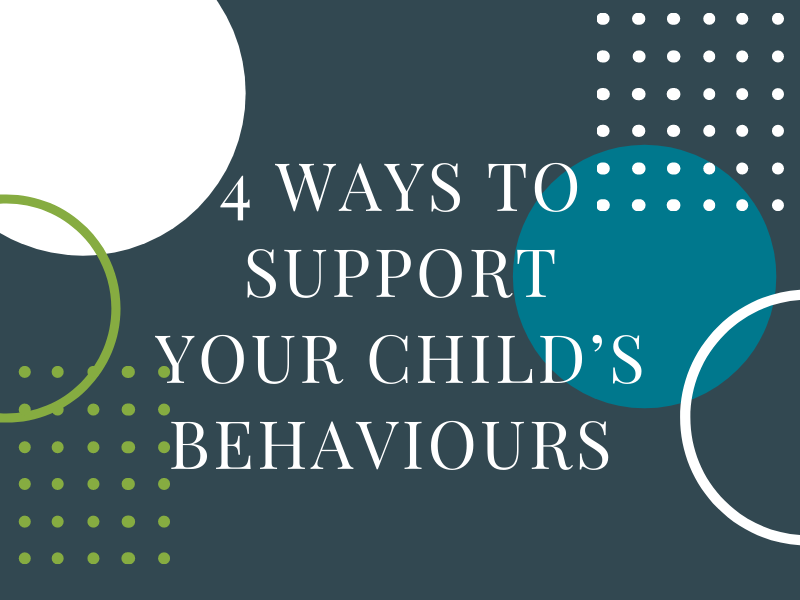4 Ways to Support your Child’s Behaviours [+ Practical ways to adapt your parenting style to support your child]
Questions on how to manage children’s behaviours are the most common I am asked about. But as we know behaviours come in all shapes and sizes, it depends on the stage of development and age of the child and also what is going on for a family. There is no one answer to solve it all.
Whether you have a strong-willed tiny tot who is finding their independence or a busy toddler or older child whose brain is still under construction because they have not yet learned to think before they do, this blog will help you!
In this blog you will learn:
4 Steps to Support your Child’s Behaviours
Practical ways to adapt your parenting style to support your child
Useful Resources to Manage your Child’s Behaviour
Some children do not yet know how to name their emotions, they sometimes use their bodies and vocal ability to express these big full-on feelings! It is then about how the parent responds and reacts to these behaviours that will make a difference.
Figuring out the ‘how to manage’ individual behaviours can be tricky at the best of times! So, in this blog I am providing some helpful information that will support your understanding of the ‘why is my child behaving like this?’ as well as providing you with ideal approaches that might help along the way when it comes to the specific scenarios you may find yourself in with your child.
4 Steps to Support your Child’s Behaviours
Step 1 : Help your Child understand their actions
Between the ages of 1-4 years, young children are learning the ability to understand the cause and effect of their actions, or learn from past behaviours, they naturally feel that the world revolves around them! They are consistently learning from observing and listening.
Try to give your child the reasons; this is the key to helping them understand what you are teaching them.
Young children need to understand why things do and do not happen.
They need to know how their behaviour affects others and why some choices are better than others.
To help children understand these ‘whys?’ parents can give reasons, for example, “thank you for listening to Dad, it’s really important that you stay close to me so I can keep you safe from the road, if you run out you could get hurt”.
When children do get worked up, through a tantrum or an argument, they don't know how to self-regulate or calm down – the parent or caregiver needs to help them and if that is to provide space then do that; but having that tantrum can be very overwhelming so more reason for the parent to be calm for them and avoid joining in the chaos with them.
Step 2 : Press Pause & Identify the Triggers
When you see an argument fast approaching with your child or you are very much in the middle of it. It is usually at this point that you want to discuss the rights and wrongs of the situation.
We all know it is unlikely we will resolve it there and then, particularly if all parties are angry or upset. If you need to talk to your child about something important, it works well when everything has calmed down – the more fuel we add the bigger the argument will become!
Remember, often there is a trigger, they could be tired, hungry, looking for attention, irritable, wanting something they cannot have, or just because (there may not always be a reason). Identify what it might be and approach it in the best way you can.
Step 3 : Name the Feelings & Stay Calm
I talk a lot about this but the more we can name the big feelings, the more often it can diffuse the high emotions or slow things down a little. A lot of children get completely overwhelmed when things unravel and don’t know what to do but get really upset, so naming them is a big part of managing it all.
One of the most powerful ways to diffuse a situation or to calm a very emotional child is firstly to keep calm yourself, I know this can be easier said than done but children rely on us to be in control.
Your child will pick up on the fact that you are remaining calm in a tense situation. If we reflect their emotions, the situation will guarantee a spill over.
[Read more on my recent blog with Dr. Colman Noctor on Supporting your Child’s Anger]
Step 4: Give Choices & Consequences
Now as we live through Covid 19, children have little choice or control over what is happening, often they will seek out ways of controlling things through their behaviours, so a great approach to this is handing over some healthy control to the child - in the form of offering some choices.
Rather than trying to insist children do something, you offer them a choice between doing what you ask and a consequence for not doing so.
For example, if they are reluctant to tidy up but really want the TV on “when you finish tidying up then you can have your TV time, but not until then, it’s up to you, let me help you” or if they are on a mission to have that snack before dinnertime, “It’s time for dinner, you can have the snack afterwards or not at all, it’s your choice”.
Practical ways to adapt your parenting style to support your child
Challenge:
My 3year-old is constantly hitting out, we do not know how to manage it, what are the steps I should take?
Solution:
1.Press pause, take a breath, stay calm and stay confident.
Avoid shouting and getting into the reasons there and then, it will have an adverse effect when everything is kicking off.
Why?
This feeding into the situation will escalate and spill over completely. Your child may want all your attention all the time. So, if hitting out gets you to stop doing what you are doing to pay attention to them, they have learned a valuable lesson: while you want to address it, this is good, it is just not paying a huge amount of attention to it until all has calmed down.
2. Acknowledge what is going on.
"I see you’re getting really frustrated about getting dressed”
3. Name the feeling.
"It’s OK to feel mad."
4. Say what’s not OK.
"It’s not OK to hit when you feel mad”, “we are gentle with each other”
5. Encourage coping skills.
When everyone’s calm—revisit the incident. "When it was time to get dressed this morning, I could see you were mad. You did not want to wear your tights. Instead of hitting when you feel mad, what could you do instead?" let’s try ‘using your words’ or “how about we decide on a quiet space for you to go to if you need space” or for the older child it is introducing the calm jar to help them manage their emotions.
THE CALM JAR
I recommend this to my own clients; some have reported back that the kids have really invested in it and that it has been a big help to them – I too have made these with my own children!
What you need:
A jar or bottle (must be watertight and labels removed)
Glitter and sequins
Food colouring
Method: you fill the jar about three-quarters full of water and add a tiny drop of food colouring (too much and you will not see the glitter). Then add some glitter and sequins to the water. Close the jar or bottle tight.
Explain to your child that this jar represents the mind, and the glitter and sequins represent our thoughts and emotions. When we are excited, angry, scared, afraid, stressed, the mind can look like this (shake up jar so the glitter is chaotic) and what we can do then is leave the jar down to settle and we breathe gently in and out as we watch the glitter settle. Explain that as the glitter settles, our thoughts and emotions settle too.
Challenge:
My 2-year-old becomes hysterical every time we need to leave anywhere when he is having fun. What can I do to help him?
Solution:
Toddlers are easily triggered when tired, hungry etc, they also do not like change or transitions, for example, when one activity finishes, or when they must leave something or someone or doing a task, like getting ready for bed, or getting dressed. Here are some tips to help you:
1.Give them a plan: Often the more we can give the children a plan of action the easier it is.
2.Give them notice: Give him a few minutes notice when it is time to go, get down to his level, be calm but firm.
3. Give direction: Tell him exactly what is going to happen. ‘I am going to put your shoes on now and then your coat, I’m then going to take you by the hand, or you can walk by yourself – you choose’
4. Keep calm: It is important for the parent or caregiver to keep calm, the more frustrated we become the bigger the situation.
Challenge:
My 4-year-old is always saying ‘no’, how should I respond?
Solution:
This is the age when kids really see how effective no can be! They are independent at this age and they can also see how much of a reaction it gets from the adult!
So remember, children really rely on our tone and body language (more than we think they do). So the next time you want your child to do something (applies to all ages!) be firm but calm and give specific direction. For example, ‘will we start getting ready for bed now? Instead ‘it is time to go to bed, we will start with pj’s and then hands, face and teeth and then a story.’
Challenge:
My 2-year-old is extremely headstrong and throws tantrums, I feel like we are constantly battling over the tiniest things, what can I do to calm things down?
Solution:
1.Give them a choice: Children really need boundaries; they push them as much as they thrive on them. However, we can offer children that control in healthy ways by using choices, for example on going outside without a coat, you say, ‘I know how much you want to go out, but you need to put your coat on, when you do, then we will go out, it’s up to you’ and follow through.
2. Find a distraction: Distraction works very well when the kids are younger.
3. Set clear boundaries: Children are strong and resilient and determined, these are great qualities, but they do cope so much better when there are boundaries, when the parent is clear, and directions and instructions are clear and to the point.
Challenge:
I don’t want to use a naughty step or a time out, what are alternative ways to help calm my child down and to avoid further tantrums or arguments?
Solution:
Time out is definitely a talking point among parents and controversial at times!
Time out can come in various forms, insisting on going to a particular spot, whether that be the stairs or bedroom etc. For others it’s about providing a space for the child to go to but it’s not a must.
Many parents use time out as a means to resolve or calm things down and provide space for the child and parent immediately! In my own experience as a parent and supporting families over the years I have not found it as effective as other approaches, that being said if it works for you that’s great.
If you are currently fighting about time out, it’s because it fuels the situation or it gets to a point where the child does not care - ie, getting up & down off the step asking how long more they have - leaving the parent even more frustrated!!
While it is important that both child and parent have space and time to calm down, if you insist on them going to a certain room or area, it will have the opposite effect – resistance.
If it works for you then this is fine, but the majority of parents have tried and tested it and it has resulted in frustrations all round, especially the parents!
So, if it’s simply not working for, what to do instead?
Let your child know that you are giving them space and leave them where they are if they are safe and will not hurt themselves or anyone else.
It is more reassuring for the parent to be able to see the child to keep an eye and make sure they are ok but at the same time not feeding into the situation.
Share with your child that when they are ready to chat things through to let you know – when things are unravelling, remember to avoid trying to resolve it there and then – wait until everyone is ready and somewhat calm.
If after 3-5 minutes and things are still overwhelming and full on – approach your child, check in with them, acknowledge feelings, and remind them when they are ready to let you know.
I know as a parent of three children, it is not always going to be as easy as that and situations will vary each time – but the more consistent you are, the more your children will see, hear, and feel the continuity and your clear approach.
On a recent survey with the Parent Support Community on Instagram, I asked 2 questions about Time Outs, here’s what they had to say:
Do you use a 'Time out'?
Do you think a 'Time Out' is effective?
“I do Time Out with my toddler. Just when he is really defiant or hurts someone. There is no kicking and screaming, he just heads to the step. Sometimes he looks glad of it! It takes him out of the situation and gives him time to calm. We have a chat and hug afterwards and I generally get my lovely little man back. If he’s in full on temper tantrum mode though we don’t use it.”
“I should qualify by saying we do time-in, where we sit together until we take a big breath and apologise.”
“I use thinking time on the stairs tell her why and that when the time is up we discuss it when she is calm or I am calm if I’ve gotten cross I often put myself on a time to calm down too”
Useful resources for when children feel & express their anger & frustration
As Dr. Colman Noctor says “There are times when parenting requires us to step back, not step in. Stepping back is not a form of neglect or lazy parenting, it is a gesture of your trust in your child that you believe they ‘have got this”.
[Read more on my recent blog with Dr. Colman Noctor on Supporting your Child’s Anger]
Natalie Costa of @powerthoughtsnc on Instagram helps children manage big emotions, she provides lots of resources and support.
Story themed books are an excellent medium and opportunity for children to listen, understand and chat about trickier life situations or the simple transitions in life, whether that be a new baby arriving, potty training starting school, bereavement or family separation. Here are some of my top recommendations to help manage challenging behaviours in toddlers and school children.
‘The big bad mood’ by Tom Jamieson
‘When I’m feeling angry’ by Trace Moroney
‘What’s going on inside my head’ by Molly Potter
‘How are you feeling today’ by Molly Potter
Providing a quiet space
As mentioned above, this is a great way to associate overwhelming feelings with a place of calm. Never insist on them going but offer it as an option.
BE KIND TO YOURSELF
Remember, parents and caregivers are human too, we are not always going to get it right all the time! Taking this time to look at what works best for you and your family is the main thing. Ask for help if you need it, keep communication open at home with your partner, your family, close friend and the children. Take time out to recharge the batteries. Many parents are feeling the same, so you are certainly not going through this on your own!
If you would like to learn more on check out a recent appearance on the Mairead Ronan Show on Today FM where I discuss the topic of harsh parenting and how to manage a tantrum.
If you are feeling overwhelmed or facing challenges with your children, I am here to help, I offer tailored 1 to 1 parent support sessions. Get in touch with me today at aoife@parentsupport.ie or if you are interested in creating a happier and calmer home, I offer a Positive Parenting eLearning Course.



